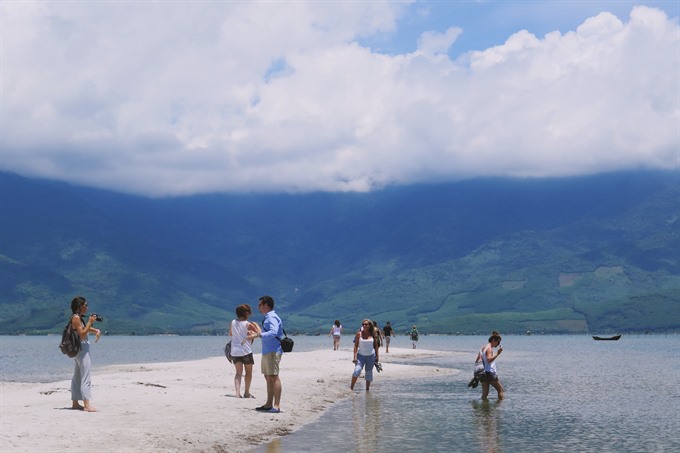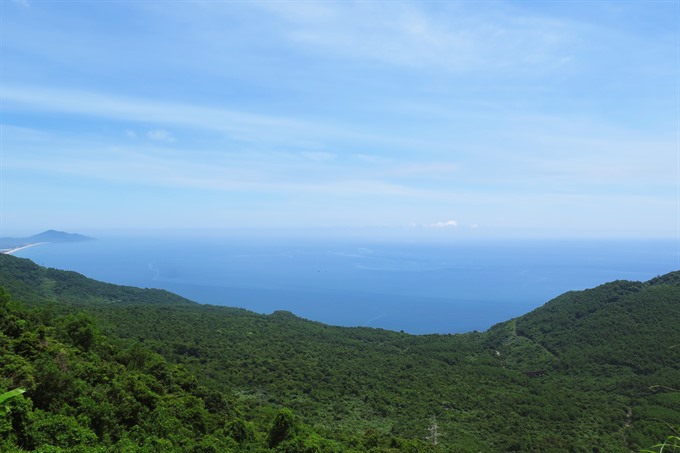Lập An Lagoon, Where Sea And Mountain Meet
Hồng Vân
Huế City has long allured travelers with its poetic Hương River, juicy street food, proud imperial city and untouched Lăng Cô beach. Yet without Lập An Lagoon, a trip there is incomplete.
My friend and I traveled to Đà Nẵng City in late June, and included Lập An Lagoon on our check list of things to do. We didn’t expect it would be such a highlight of the trip.
We rented a motorbike and drove north from Đà Nẵng. The route leading to the lagoon is easy to find and the road is not crowded.
The route running through the Hải Vân tunnel is only about 30km. Yet I would recommend driving along the Hải Vân pass, which makes the route about 10km longer,
We left the hotel at 7am, having breakfasted on mì Quảng (a signature noodle dish of Quảng Nam Province), filling up on petrol before hitting the road.
From central Đà Nẵng City we drove along Nguyễn Tất Thành Street, which took us along the seemingly endless beach and blue waters beyond, dotted with tiny boats.
Leaving the road and making a few turns brought us to Hải Vân Pass (loosely translated it means pass "of the Ocean Mist"), with its breathtaking scenery. The route, which runs for about 20 kilometres, bends along the densely forested Bạch Mã Mountain, showing glimpses of Lăng Cô beach. The green of the trees, the blue of the sea and the lightly clouded sky is a welcome respite from the concrete jungle of the city.
With the availability of a tunnel running through the mountain, completed in 2005, most of the transport now uses the tunnel, leaving Hải Vân Pass to mostly motorbike and occasional truck traffic.
 |
| Photo-op: Sand dune ’road’ running from the bank to almost the middle of the lagoon. |
Hải Vân Pass, a passage of major strategic importance in Việt Nam’s history, represented a major barrier to any land army that attempted to move between the northern and central regions of the country. Nowadays, it’s a perfect motorbike ride, with the road climbing to the peak at 500 metres.
Travelling by motorbike does not only open up horizons, it provides a sense of freedom compared with a car or bus window. Everything looks surreal. The horizon, which sepearates the sky from the beach, seems to be diminishing. The sky seems to melt into the blue of the water.
My friend, a daring traveler who has driven through many passes in the northern mountainous areas of Việt Nam, says this is a different experience for her. “In northern mountainous areas, I am overwhelmed by the grandeur, the roughness of the mountain landscape. Here I can also feel the smooth, delicate, soft blend of mountain and beach,” she said.
After exisitng Hải Vân pass, we turned onto a local road and headed for the quiet, peaceful lagoon.
A road separates the lagoon from the local houses. On one side is the familiar, characteristic sight of rural life – old, modest houses surrounded by dense plants and fruit trees. On the other side is the untouched, landscape of mountain and water twinkling under the bright sun.
 |
| Peaceful ambiance: Lập An Lagoon with the spectacular Bạch Mã mountain as its backdrop. |
Lập An Lagoon, located near Phú Gia Bridge of Lăng Cô town, is 800ha large and one of the most scenic brackish water lagoons of Huế City to its north.
The water is clear affording a view of a variety of creatures, including fish, sea cucumber and oysters.
My friend and I sat for a while under the trees, contemplating the sight, and when we drove further, we realised it is just the beginning of this majestic journey.
We happened to find a sand dune stretching from the bank of the lagoon almost to its middle. Though excited by the discovery of this "road", we were unsure whether it was safe to walk on. A local tour guide, speaking in a heavy Huế dialect, assured us and even offered to take a photo of the two of us before we moved on.
 |
| Strategic location: Hải Vân Pass is a perfect choice for a short motorbike trip, affording magnificent views. |
In his heavy dialect, charming to the ear of a northerner like myself, the tour guide spoke proudly of his hometown’s attraction. He said the lagoon was not only a toursist attraction, but a place where households grow oyster.
Every afternoon, when the tide ebbs leaving behind little snails in beautiful shapes and various size, locals go there to collect oyster and sea cucumber.
The lagoon is the most romantic when sunset falls, he said. That was sad news for us since we had to be back in Đà Nẵng in the afternoon.
When we arrived at the lagoon, it was almost empty. The tour guide, along with his two French tourists, were the first visitors we met. We walked for a while on the sand dune road, seeing a few more tourists posing for photos with the lagoon and spectacular Bạch Mã Mountain range an ideal backdrop.
We then drove around the lagoon before travelling to nearby Lăng Cô beach, enjoying some seafood, and winding up a perfect trip that far exceeded our expectations. — VNS
Submarine DeepView24 To Serve Visitors At Vinpearl Nha Trang
US dollar billionaire Phạm Nhật Vượng, Chairman of Vingroup, will put into operation DeepView 24, a spectacularl... Read more
Bánh Khọt A Must-try At Vũng Tàu Beach
Bánh Khọt (mini savory pancake) is a great breakfast dish that visitors must try when staying at Vũng Tàu beach... Read more
Explore The First Museum In Southern Việt Nam
The HCM City Museum of History is located at Nguyễn Bỉnh Kiêm Street in District 1, set beside Saigon Zoo and Bota... Read more
Explore Hidden Waterfall In Central Việt Nam
Tà Puồng Waterfall is one of Việt Nam Central’s most impressive natural sights, with an unspoilt beauty. Read more
Bat Pagoda, Home Of Thousands Of Bats In Mekong Delta
The Cửu Long (Mekong) Delta is home oi about 600 Khmer pagodas and each temple has a unique feature. The Bat Pago... Read more
100-year-old Bửu Sơn Pagoda Rests On One Pillar
The 100-year-old Bửu Sơn Pagoda in Đồng Nai Province, built in the 18th century, rests on only one pillar. Read more

